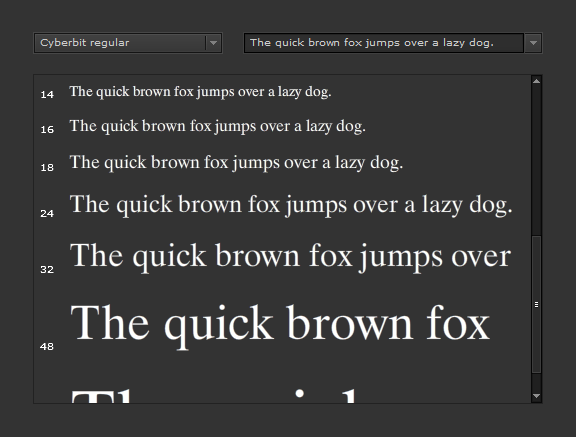Posts in Category: Typography
Font streaming
Update: Now the project is on google code
A promise is a promise 😉 Now you can download sources of my library handling progressive download of fonts for Flash.
I clean up all to separate different works.
1. Waterfall demo
Main demo proof of concept. Demonstrate the system with non embed fonts where chars are loaded when them entered. Also give an example to the usage with Flex on custom components (through Text.fontContext)
2. Font cache generator
An AS3 Command line executable (made with redtamarin) allow quickly generate fonts cache. A binary file format used to serve fast small amount of font data (optionaly a format used to storage data).
Use it to add more supported fonts for build in test (Waterfall demo). For generate font cache files simply use console: fcgen embed_fonts.swf (or use --help for display help), put generated files (by default *.foncache) in fontcache folder and update fontlist.xml
This contains also 2 others version, an old version in AS3/SWF by passing the SWF file by clicking on stage first and save the result by click second, and an not working flex alternative (read only some information about the SWF file passing through the button “open”).
3. SWF template base
Not realy important but used for generated the template used in library for generate dynamically SWF file contain fonts data.
Here miss an other part used to modify the SWF template for keep only needed informations (remove debug, metadata …)
And finally an example to embed font with Flex SDK.
Notice
I’m currently work on a big multilingual project which use it. But the server get in trouble (we suppose) with PHP when handling huge file like for Arial Unicode MS for CJK texts. We use a (temporary ?) solution by caching requested files and serve again for same requests. This not include in sources.
Beyond, is hard to get styles applied on HTML text. This for what, I had create a class handling HTML text and parsing it to know used text/fonts, improve HTML support by TextField (by some hack and HTML transformations). Is not yet include in souces.
- Can have memory impact or CPU time when intensive usage for large range of chars (need be more tested)
- Not all font information supported, but maybe no real impact (Small text ? and language code ? )
- Server performance (PHP parsing and generating are time consumer) (need enhance by optimizing the script or use an other language like C/C++ or use a DB for stocking gyphs data instead a unique file)
- Only TextField can use it, not supported by new Flash 10 TextEngine, it use an other way to embed font (CFF Fonts) (need support DefineFont4 tag)
- The font embedded by Flash are cleaner than Flex SDK, but Flash CS3 allow generate fake italic and bold whereas Flash CS4 allow used real font styles (Light, Condensed, Heavy …)
No licence explicitly declared but sure i think as GPL, no AS3 package, more examples, SVN, dedicated page, real name, logo … this will come.
Streaming de polices
Je viens de mettre au point un système qui permet d’utiliser des polices embarquées, mais seulement de charger les caractères nécessaires.
Le système est simple :
- Le server de streaming
- Il va s’occuper de la sélection des caractères à retourner en fonction de ceux demandés.
- Le client
- Il va s’occuper de faire le choix des caractères nécessaires (en fonction du texte à afficher) ainsi que le leur rapatriement et l’intégration aux polices à utiliser.

La police Arial Unicode MS, contient la majorité des plages unicodes : Latin, CJK (Chinois, Japonais, Coréen), Cyrillique, Hébreu, …
A titre d’information :
- ShinGoPro-Medium_regular.fontcache 3,38Mo (A-OTF-ShinGoPro-Medium.otf 3,11Mo)
- Arial Unicode MS_regular.fontcache 9,96Mo (Arial Unicode MS.otf 23,28Mo)
- CodingFontTobi_regular.fontcache 53Ko (cft.ttf 47Ko)
- Coca Cola ii_regular.fontcacheCoca 20Ko (Cola ii.ttf 58Ko)
- Futura_boldItalic.fontcache 27Ko (Futura Bold Italic.ttf 35Ko)
- Futura_bold.fontcache 25Ko (Futura Bold.ttf 34Ko)
- Futura Heavy_regular.fontcache 28Ko (Futura-Heavy.otf 17Ko)
- Futura Heavy_italic.fontcache 29Ko (Futura-HeavyOblique.otf 17Ko)
- Futura Light_regular.fontcache 29Ko (Futura-Light.otf 17Ko)
- Futura_italic.fontcache 29Ko (Futura-Oblique.otf 16Ko)
- Futura Heavy_regular.fontcache 28Ko (Futura.otf 16Ko)
- Futura Condensed_regular.fontcache 28Ko (FuturaCondMedium.otf 22Ko)
- Microsoft YaHei_bold.fontcache 8,7Mo (Microsoft YaHei Bold.otf 14,69Mo)
- Microsoft YaHei_regular.fontcache 8,89Mo (Microsoft YaHei.otf 15,04Mo)
- SegoeUI_regular.fontcache 252Ko (segoeui.ttf 415Ko)
Total 31,48Mo (56,81Mo)
Flash et les langues “exotiques”
Comment faire quand on a un Flash avec du texte dynamique en français, anglais, russe ou chinois ?
Déjà le problème c’est qu’on ne peut pas utiliser qu’une seule police. Le graphisme utilise une police, mais celle-ci, dans la majorité des cas ne gère pas tout les caractère Unicode.
Faire une concession sur le graphisme, ou utilise 2 polices ?
Une police qui gère le chinois ? Pas sûr, par exemple avec la police PMingLiU (police par défaut sur XP gérant les caractères asiatiques) avec les caractères chinois tous (Chinois traditionnel tous + chinois simplifié) sois 21664 caractères, on rajoute 12Mo au SWF…
Après quelques tests, le seul moyen que j’ai trouvé, c’est d’utiliser pour les langues européennes (romanes et germaniques) la police du graphisme (exemple : DIN ou Helvetica) et pour les autres langues utiliser la police _sans.
Le seul soucis c’est que pour du texte qui utilise la police _sans, il faut le mettre en myTextField.embedFonts = false; sinon elle n’apparaitra pas. De ce fait, on ne pourra pas appliquer des transformation tels que la rotation ou le scaling au champs texte quand on utilise _sans. Seule l’alpha peut être appliqué en mettant le champ texte en mode de fusion BlendMode.LAYER
La seule chose qu’il reste à faire, c’est détecter quand on doit utiliser _sans ? Quelques pistes :
- Identifier la langue utilisé et faire une correspondance (exemple l’attribut lang et/ou xml:lang)
- Vérifier chaque caractère si il exsite dans la police, sinon utiliser _sans avec
myFont.hasGlyphs(myString);
Informations complémentaires :
